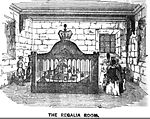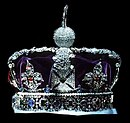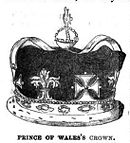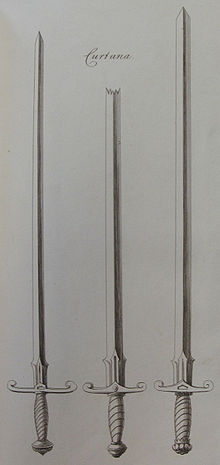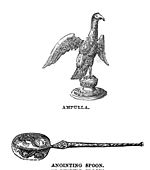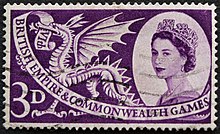Crown Jewels of the United Kingdom
The British Crown Jewels are considered the most valuable collection of diamonds and jewels and are kept in the Tower of London . However, the part of the crown jewels exhibited there is only a small part of the total treasure.
The crown jewels include, among other things, various crowns , sceptres (either with a cross or a dove), orbs , swords , spurs and rings . In addition, various items of clothing, such as the royal robe, are also counted among the crown jewels.
The crown jewels are only worn on special occasions, especially during the coronation ceremony of a new monarch and the annual opening of parliament .
History of the Crown Jewels
There had never been a permanent royal crown in England's history, as in the Holy Roman Empire. After the conquest by the Normans under William the Conqueror (1066), two crowns were used at every English coronation. The heavy royal crown is used in the actual coronation act. It has traditionally been adorned with lily leaves since Wilhelm I. A second, known as the State Crown , is significantly lighter and was worn on official ceremonial occasions. This custom continues to this day.
The crown jewels were kept as sacred objects in Westminster Abbey , the coronation site of the English kings, but where the crown jewels were also stolen in 1303. In 1339 Edward III pledged . to finance the Hundred Years War the royal crown to the Trier Elector Baldwin of Luxembourg, who supported him, for 50,000 guilders. Eduard took his time to redeem the crown until 1343, so that Baldwin, who had meanwhile gone over to the French side, even threatened to sell the crown in the meantime.
Twice in history, significant parts of the crown treasure were either completely or partially lost. The crown treasure was lost for the first time during the First War of the Barons with the sudden death of King Johann Ohneland in 1216. It is possible that the treasure sank with part of the king's entourage when crossing the Wash shortly before John's death. Among the treasures that were still used at the coronation of King John and that were missing at the coronation of his son were the coronation crown of England decorated with lilies, precious royal robes, a pair of golden spurs, a large cross, a golden cup, the scepter with the dove, a valuable belt, gloves and shoes, as well as two swords, one of which is said to have been the sword of Tristan. Since the first coronation of the new King Heinrich III. due to the civil war in 1216, there was another coronation ceremony in 1220, for which numerous crown insignia were made. The second time, the crown jewels were lost towards the end of the English Civil War and the subsequent Commonwealth of England . After the execution of King Charles I in 1649, the new ruler Oliver Cromwell had the entire crown treasure dismantled and sold or melted down as a symbol of the hated tyrant rule. After the restoration of the monarchy , new crown jewels had to be made for the coronation of the new King Charles II on April 23, 1661, but some of them consisted of the old material. The rebuilding of the crown jewels cost the enormous sum of £ 13,000.
The oldest surviving crown of the English crown jewels is the so-called Palatinate Crown in the Residenz Museum in Munich , which escaped destruction under Oliver Cromwell , as it had come to Germany from England as a dowry from Princess Blanca as early as 1402 .
Since Charles II, the crown jewels have been kept in the Tower of London , which has long served as a treasury for the private jewels and treasures of kings. However, the guardians of the crown jewels secured an additional income by allowing the jewels to be viewed for a fee. In 1671, the robbery of the Edwardian crown and the imperial apple by Thomas Blood could only just be prevented. In 1815, a visitor damaged the State Crown, and when the Grand Storehouse in the Tower burned down in 1841, the crown jewels were barely rescued.
During the Second World War , in view of the feared German invasion , the jewels were to be relocated to Canada and kept there by the Sun Life Insurance Company in Montreal . Eventually, however, only the Bank of England's gold reserves were relocated to Canada, while the Crown Jewels were moved to Windsor Castle . The main reason for this was that traditionally the crown jewels were never allowed to leave the country, and a loss of the crown jewels in the Atlantic Ocean was perceived as far more serious than their capture in the event of a German invasion.
storage

Since 1967, the Jewel House , where the Crown Jewels are kept, has been in the Waterloo Barracks in the Tower of London, where they can be viewed by the public.
Every year in January, following an inspection in December, they are cleaned by the court jeweler. This happens after the tower closes at night so that all parts of the crown treasure can be seen publicly during opening times. The entire cleaning process usually takes around ten days. In addition to the annual cleaning interval, all items that have been used for ceremonial use by members of the royal family during the year are checked and, if necessary, cleaned.
Crown
The St. Edwards Crown (St. Edward's Crown)
This solid gold crown, made in 1661, is the actual royal crown of England and is only used at the coronation.
The Edwardian crown commemorates King Edward the Confessor (1042-1066). It is a gold lily crown set with 444 precious stones and pearls. It weighs no less than 2.25 kilograms. Until the 19th century it was worn by almost all English kings.
It was made of silver in 1838 for the coronation of the young Queen Victoria and rebuilt in 1937. It is covered with thousands of diamonds and also bears the ruby of the Black Prince , which is, however, a spinel . It is used on special occasions, such as the opening of parliament.
Traditionally, the English crown jewels are never allowed to leave the country, and so this crown was made for the coronation of George V as Emperor of India in Delhi in 1911. It is a finely crafted crown of the usual patterns in England and bears a number of emeralds , rubies, sapphires , 6,100 diamonds and a very valuable Indian ruby. The crown was designed by crown jeweler Garrard & Co and cost £ 60,000. It weighs 970 grams and the considerable weight of the crown meant that King George complained of headaches after wearing it. It was never used again and has been kept with the English Crown Jewels since its return in 1913.
The Crowns of the Prince of Wales .
The older crown was created for the initiation ceremony of Prince Frederick Louis (son of King George II and father of King George III ) in 1729 and is made of gold with only one bow and is not set with precious stones.
In 1902 the crown of George, Prince of Wales, was created for George V as the then Prince of Wales.
The newer crown was created for the investiture of the current Prince of Wales ( Prince Charles ) in Caernarvon in 1969 and is the youngest in the royal collection.
Investiture insignia from 1911 (crown, staff, ring, sword and robe or cloak with belt and sash) and 1969 are on loan to the National Museum of Wales in Cardiff .
The crown of the Queen Elizabeth (Crown of Queen Elizabeth)
It was made for the coronation of the wife of King George VI, who later became "Queen Mum". This crown is the first of the crown jewels made not of gold, but of platinum. It contains the Koh-i-Noor diamond. Elizabeth wore them, the arches had traditionally been removed, including for her daughter's coronation in 1953.
The Crown of Queen Mary
It was made for the coronation of King George V 's wife, Marys von Teck , in 1911. It originally contained the Koh-i-Noor diamond, which is now on Queen Elizabeth's crown. The brooch with the Cullinan V was inserted in its place . The third and fourth largest stones of the Cullinan diamond were worked into the crown: Cullinan III in the upper cross and Cullinan IV in the browband. Queen Mary often wore the lower part of her crown as a diadem .
Small diamond crown of Queen Victoria
Queen Victoria preferred this crown, created in 1877, to the Imperial State Crown . It is set with over 1,300 diamonds.
The crown of Queen Mary of Modena (Crown of Mary of Modena)
This crown was made in 1685 for the coronation of Queen Mary of Modena, the second wife of King James II . It is 20.9 cm high and weighs 890 g. The crown was set with rented stones, which were later replaced with 38 very large diamonds and 652 pearls. It contained the "Ruby of the Black Prince". It later served as the state crown and was reshaped to match the then current fashion on Queen Mary's II head. Queen Anne as well as King George I used it as a state crown. The next royal wives - Caroline von Ansbach , Queen Charlotte and Queen Adelaide - used them again as the secondary queen's crown.
Diadem of Mary of Modena / State Crown of George IV (George IV State Diadem)
The diadem was also worked in 1685. The broad, solid gold ring is richly set with an ornament of diamonds. The upper edge, completely lined with pearls, forms a flat point that is crowned by a free-standing diamond. As was quite common at the time, the gemstones were only borrowed for the coronation ceremony and were later exchanged for less valuable ones. The Modena diadem was modified several times and used by subsequent queens up to Queen Adelaide in 1831. Male exception: King George I wore this diadem in his coronation procession as a state cap.
The State Crown of George I (State Crown of George I)
Manufactured in 1714 as a replacement for the state crown of Charles II. Replaced by the Imperial State Crown in 1838 by Queen Victoria.
The Coronation Crown of George IV
George IV wanted to replace the Edwardian crown with this crown made in 1821, but he did not succeed. It has not been worn since 1823. In 2019, Queen Elisabeth II wore the coronation crown of George IV at the opening of parliament . The Imperial State Crown, which is otherwise used for this, was meanwhile placed on a table next to the Queen.
The Crown of Queen Adelaide
It was made for the coronation in 1831 and was worn exclusively by Queen Adelheid.
The Crown of Queen Alexandra
It was made in 1902 and has 8 half-bows, which is unusual for British crowns.
scepter
The scepter with the cross
It originally dates from 1661, but was expanded under the reign of Edward VII in 1907 and symbolizes royal power. It is 92.2 cm long and has many precious stones, including the 530- carat Cullinan I diamond . The sovereign carries this scepter in his right hand during the coronation.
The "scepter with the dove"
The scepter is a staff made of gold and measures 110 cm. A golden cross with a white enameled dove rises on its top. Their eyes, beak, and feet are made of gold. In addition to other decorations, the scepter has ribbons of enamel and precious stones, goldwork and colored precious stones, enamel and diamonds in the center. The dove symbolizes the Holy Spirit and it was believed that he guides the actions of kings. It is for this reason that a “scepter with a dove” has been used by kings for centuries. The sovereign carries this scepter in his left hand during the coronation.
The ivory scepter of the queen consort
dates from 1685.
The queen scepter with the cross
also dates from 1685.
The St. Edwards Staff
The staff is a 140 cm long golden scepter, which is iron-clad at the lower end. A ball with a paw cross sits on its tip . Already under Henry VI. a staff of that name was carried during the coronation ceremony. There is evidence that the current staff was first used at the coronation of Charles II in 1661. The baton is given to the ruler by the Dean when he enters the Abbey Church of Westminster, carried in front of him and returned at the end. At the end of the coronation service, it is placed on the altar and remains there.
Rings
The golden coronation ring ( Sovereign's Ring )
Also called the Wedding Ring of England , was made for King William IV in 1831 and was used by all monarchs (except Queen Victoria ) for coronation. It is made of gold and has a large sapphire (15.2 mm × 12.2 mm × 7.4 mm) with fourteen surrounding diamonds and weighs 84.45 carats. Above him are five rubies which represent the cross of St. George . It is put on the ring finger of the right hand at the coronation and symbolizes the ritual eternal connection between the ruler and his people, which can only be broken through the death of the king.
The Queens-ring ( Queen Consort's ring )
was also made for Queen Adelheid in 1831 and consists of a ruby (12.5 mm × 9.0 mm × 5.9 mm), which is framed by fourteen diamonds. On the ring itself is a narrow band of rubies. It weighs 50.15 carats.
The Queen Victoria's Ring
Queen Victoria's ring was specially made for her coronation in 1838 because her fingers were very slender and there was fear of slipping. It is modeled on the golden coronation ring. It weighs only 42.74 carats, the large sapphire measures 14.6 mm × 13.2 mm × 8.5 mm and is surrounded by 20 diamonds. Five rubies are arranged in a cross shape on the sapphire. The words Queen Victoria's Coronation Ring 1838 are engraved on the circlet.
Swords
There are five swords in the royal collection of the Tower of London.
The State Sword ( Great Sword of State )
The largest of them is the great state sword, a broad sword with a blade over 81.28 cm, with a total length of 128.5 cm and a weight of 2.58 kg. The handle is made of gilded metal and the creator of this weapon designed it in 1677 or 1678 with the coats of arms of Westminster (a portcullis), France ( Fleur de Lys ), Ireland (harp) and Scotland (thistle), the imperial orb and other emblems. The quillons are also made of gold-plated metal and one half is in the shape of an English lion and the other half in the shape of a unicorn, based on the coat of arms of Scotland . The scabbard itself is covered with purple velvet and provided with gold-plated metal plates in the same design.
The Jeweled Sword of State
The Jeweled Sword of State is considered to be the most beautiful and valuable sword in the world. It was made for George IV at a cost of £ 6,000. It presents an abundance of jewelry in all colors and gold. At the coronation, this sword is held as one of the military emblems by the “guardian of the house of jewels”, and after it is presented to the monarch, it is given as a gift of honor to the church. It is then triggered again.
The sword of mercy ( Sword of Mercy )
It is also called Curtana and is also known as the sword Edward the Confessor . Its blade is blunt and is therefore indicative of mercy.
The sword of justice Spirituals ( Sword of Justice to the Spirituality )
The Sword of Justice to the Temporality .
Chivalric regalia
The Spurs ( Spurs )
The spurs are made of pure gold and richly decorated and have belts made of purple velvet, which are embroidered with gold. They are also known as "St. George's Spurs ”and are one of the symbols of the knight and chivalry and, together with the sword, the military symbols of the monarch. At the coronation, these spurs are presented to those in power to be deposited on the altar immediately afterwards. They are later triggered by paying a fee.
The Bangles ( Bracelets )
These are 2.54 cm wide and 5.1 cm in diameter. They are made of pure gold and lined with purple velvet. Emblems of the three kingdoms (England, Scotland and Ireland) as well as the fleur de lys of France are enameled on the surfaces of the bracelets. In 1953 new ones were added, which were a gift from the Commonwealth of Nations to the new queen.
The orb ( The King's Orb )
The imperial orb is made of unmarked gold and set with over 600 precious stones and pearls. It weighs 1.32 kg and was made by Sir Robert Vyner for the coronation of Charles II in 1661. Its fine amethysts , on which the cross stands, are striking . The diameter of the sphere is 15.24 cm. It has a round gold hoop on the center circle, which is decorated with fine pearls, diamond clusters and white and red enamel. The central stones of these grapes are alternating rubies, sapphires and emeralds. An arch runs over the upper part of the sphere and is crowned by a cross, which sits over a large amethyst. The contours of the cross are covered with diamonds and there are three large diamonds in each arm. In the center of the cross lies an emerald on one side and a sapphire on the other. The stones in the middle of the two sides are surrounded by diamonds and between the lower foot of the cross and the amethyst is a collar of small diamonds. There is a large pearl at the end of each of the upper arms of the cross and another in each of the four inner corners.
The orb of the Queen ( The Queen's Orb ).
Liturgical Regalia
The ampoule
The ampulla that contains the oil for the anointing of the monarch is made in the shape of an eagle. It measures 22.86 cm in height with the base. The wingspan is 23.78 cm. It weighs 310 g and is made of pure gold. The cavity of the body is able to hold 136 g of oil. The head can be unscrewed to fill in the oil. The beak serves as a spout.
The spoon
The handle is undoubtedly old, probably Byzantine. The spoon is approximately 7 inches long.
Goblets and paten
They are made of solid gold and all bear the coat of arms of King Wilhelm III. and Queen Maria II. Traditionally, the altar of Westminster Abbey is adorned with the sacred objects created in 1691 for the coronation.
The baptismal font
The tall, lidded baptismal font with its bowl dates back to 1660 and was made by a goldsmith with the initials RF. The bowl was originally made as the edge of the baptismal font, but is now firmly attached to the inner part and is used as an altarpiece. George IV was the first to be baptized over this bowl. A small baptismal font was made in 1840 for the baptisms of Queen Victoria's descendants.
Holy Thursday dishes ( The Maundy Dish )
was prepared in 1660 gold-plated silver to the green Thursday - alms receive (especially embossed coins). The number of coins increases with the age of the monarch.
Commodities
The following items were used as a centerpiece at the large banquet after the coronation or in the royal palaces and are now in the crown treasure.
The communion plate ( The Communion Plate )
are actually two pieces, a paten and a goblet; they are made of pure gold and date from the 17th century.
The Exeter Salt Barrel ( State Salt ).
The Exeter salt barrel was created by Johann Hass from Hamburg in 1630. It is 45 cm high and has the shape of a castle with towers and is set with 73 jewels. It was donated to King Charles II by the City of Exeter and cost £ 700, now around £ 750,000.
The Elizabeth Salt Barrel ( Queen Elizabeth Salt )
dates from 1572. A direct connection between this object and Queen Elizabeth I has not been proven.
The Fountain ( The Fountain )
was given to King Charles II by the city of Plymouth and is commonly referred to as a wine fountain. However, it is more likely to have been used for warm water with censer, in which the dinner guests could rinse their cutlery and fingers. The large mussels were well suited for this, while bottling wine glasses is impossible. The fountain is attributed to the Hamburg jeweler Peter Oehr the Elder and would therefore have been made around 1650.
The royal tableware ( St. George Salts )
was put together from 1661 to 1821 and was last used at the coronation banquet of George IV. It comprises twelve parts each. The salt barrels bear an equestrian figure and gave the name to all the dishes.
The wine cooler
is a very large gilded silver vessel weighing 8,000 ounces . It is decorated with maritime symbols and dates from 1824.
The Office bars ( The Maces )
Originally battle clubs, they became symbols of authority and are only used today for the opening of parliament and royal proclamations . There are eight copies in the royal collection, two from the reign of Charles II, two from the time of Jacob II, three from the time of Wilhelm and Mary, and one of the coats of arms of Queen Anna and George I. Parliament is not on display in the Tower, but one in the House of Commons and the other in the House of Lords .
The silver trumpets ( The Silver State Trumpets )
There are sixteen in number that were only used during the coronations. They all date from the years 1780 to 1813 and are no longer used. Ten of these ceremonial trumpets still have their banners embroidered with the royal coat of arms.
Other important pieces of jewelery from the Royal Collection
The diamond diadem 1820
Owing to its frequent appearance on postage stamps and coins, this exceptionally beautiful headdress, incorporating the national emblems of England, Scotland and Ireland, is probably the most famous piece in Queen Elizabeth II's jewelery collection . It consists of 1,333 diamonds , including a pale yellow four-carat -Brillant in the middle of the front cross, has a diameter of 19 cm and is 7.5 cm high. The diadem has been worn regularly (slightly modified in each case) by queens and king-wives since Queen Adelaide .
This use contradicts its origin, however, because it was made in 1820 for the famous and extravagant coronation of George IV. He wore it over a large Spanish-style velvet hat during the 1821 ceremonies at Westminster Hall and the foot procession to Westminster Abbey .
The order for the diadem was awarded to the court jeweler Philip Rundells in 1820 and completed in May of that year. The design, likely created by Rundell's chief designer Philip Liebart, echoes something of the plan for the unexecuted Imperial State Crown George IV, designed by Liebart in the same period and which featured the national emblems instead of the traditional fleurs de lis . Together with a diamond brooch in the shape of a bow (later changed for Queen Victoria's garter armband) the bill came to the large sum of 8,216 pounds. This included £ 800 rent for the diamonds - the stones were regularly rented for use in coronations until 1837 - calculated as a percentage of the value of the stones. Due to the unfortunate trial of Queen Caroline , the coronation was postponed for a year and so the rental costs increased. Normally the stones would have been returned to Rundells after the coronation, but in this case there is no evidence that the finely crafted diamond setting and crosses, a masterpiece of the new transparent style, have been dismantled. Likewise, there is no evidence that the king finally bought the stones, so it could be that the debt under the contract was settled by a discreet swap with old stones from the extensive collection of George IV.
Today the diadem is worn by Queen Elizabeth II on trips and before and after the opening of Parliament and is kept in the Royal Collection .
Individual treasures
Great Star of Africa
At 530.2 carats, the Great Star of Africa is the second largest cut diamond in the world. It was cut in 1905 from the largest rough diamond ever found, the Cullinan , and is in the coronation scepter. In addition to the Great Star of Africa , the Cullinan also produced the Lesser Star of Africa with 317.4 carats and 103 other diamonds between four and 98 carats. These diamonds are incorporated into other British Crown Jewels, including the Imperial State Crown .
Koh-i-Noor
The Koh-i-Noor ("Mountain of Light") with 108.93 carats is certainly not one of the largest, but due to its special cut it is nevertheless one of the most valuable diamonds in the world. There are also many legends about him, as his origin is unknown. According to legend, the Koh-i-Noor , part of the legendary 240-carat Great Mogul be diamonds from which has disappeared for about 200 years. Once he is said to have adorned the Indian peacock throne as an eye. Another legend has it that he who wears the Koh-i-Noor in the crown will rule the world . At least in the case of its owner, Queen Victoria, this relation applied to a certain extent. However, the Koh-i-Noor should only be worn by women, as a legend says that it is supposed to bring harm, even death, to men.
The Koh-i-Noor is said to have been owned by the Afghan Baraksai tribe. The Mohammadzai clan emerged from the Barakzai tribe. According to tradition, the Koh-i-Noor is said to have adorned Dost Mohammed's turban . After Dost Mohammad Khan had to go into exile in India after the first Anglo-Afghan war , the Koh-i-Noor also disappeared from the property of the Mohammadzai clan.
The Black Prince's ruby
The ruby of the Black Prince ( The Black Prince's Ruby ) from the British crown jewels in reality, a ruby , but a red spinel . It is located in the imperial state crown and, according to tradition, was given to this prince by King Peter I of Castile after the battle of Nájera in 1367. He himself is said to have received it by murdering the King of Granada . The Black Prince wore it on his helmet, as did King Henry V in the Battle of Azincourt in 1415 . Henry VIII transferred it to the Crown Jewels. During the Commonwealth, the stone was sold for £ 15 to a Mr. Cooke, who returned it to Charles II. Since that time he has been in the respective state crown.
Replicas
In total there are two complete sets of copies of the Crown Jewels. One of them is in Fort Catherine , Bermuda . For the coronation in 1953, replicas were made, which the airline British Airways gave to the queen. After the coronation, they toured the world as an exhibition. The jewels still exist but are not on display.
It is known that after an attack by the IRA on July 17, 1974 on the Tower of London, the originals were exchanged for copies in the event of another attack.
Individual replicas of the crown jewels used in the coronation service are in the possession of Westminster Abbey and will be used in the rehearsals of the coronation. They are also not open to the public.
literature
- Martin Rivington Holmes: The Crown jewels in the Wakefield Tower of the Tower of London. Ministry of Works official guide. HM Stationery Office, London 1961.
Web links
Individual evidence
- ↑ Ernst Gillmann (Ed.): Our Church in the Rhenish Oberland. Simmern 1954, p. 139.
- ^ The British Monarchy: The Crown Jewels. Retrieved February 2, 2016 .
- ^ František Šmahel : Heresy and Premature Reformation in the Late Middle Ages (= writings of the Historical College in Munich. Volume 39). Oldenbourg Verlag, 1998, ISBN 3-486-56259-2 , pp. 105 and 106 ( digital scan ).
- ↑ Thomas Blood: Hunt for the Crown Jewels. Historio in May 2011.
- ^ The Tower of London: The Crown Jewels: A brief history. Retrieved February 2, 2016 .
- ↑ The Queen swaps her 2.5lb Imperial Crown for a lighter tiara , Mark Duell and David Wilkes, Daily Mail, October 14, 2019
- ↑ Anna Keay: The Crown Jewels . Thames & Hudson, 2011, ISBN 978-0-500-51575-4 , pp. 30 ( google.com ).
- ^ The Royal Collection: The Diamond Diadem. Retrieved February 2, 2016 .


